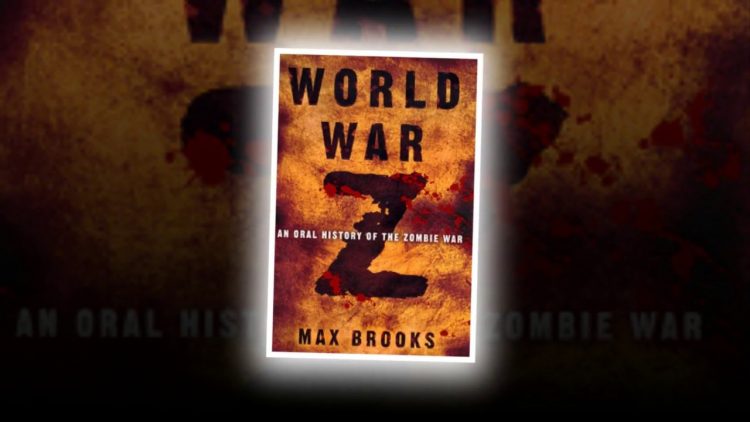
Like many zombie fans, I read Max Brooks’ first book, “The Zombie Survival Guide,” enjoyed it, and appreciated what it did for the zombie genre: it played a key role in drawing a whole new generation of fans into obsessing (it’s okay, you can admit it) over our favorite shambling monsters.
Also like many zombie fans, I was skeptical about Brooks’ second novel release, “World War Z,” for a number of reasons:
- It’s such a radical departure from both the tone and scope of “The Zombie Survival Guide.” How could this man who had written a highly comedic, tongue-in-cheek pseudo-handbook dealing with how to defend yourself from an undead attack so abruptly switch gears and write a very serious faux-retrospective journalistic piece dealing with the very weighty issues and serious effects of the aftermath of a worldwide zombie outbreak? And more importantly, how could he possibly be successful with it?
- His first book took so many people by surprise and was so wildly successful…even if “WWZ” was well-written, how could Brooks possibly hope that lightning could strike twice for him and he could have this second book become as successful as the first?
- What – or more importantly, how – could Brooks possibly write in this book that would make it unique and set itself apart from the myriad of other “zombies invade, people get eaten” books that were starting to saturate the market at the time of “WWZ’s” release?
Fortunately for all of us, with “World War Z” Brooks not only met the high expectations set by his first novel release, in my humble opinion he actually surpassed expectations by creating something even better: a story that felt real, characters that the reader can truly empathize with even though we don’t know them very well, and a tremendously engaging tale that felt less like speculative fiction and more like historical fact.
“WWZ” is a unique tale of a worldwide zombie pandemic where casualties were high but humanity actually survived. That basic plot breakdown in itself may not sound so unique to you, but it’s the presentation of the tale that really helps this book stand out from the rest. The narrative is presented as a story told after-the-fact by first-person eyewitness accounts, and even though we don’t get to spend much time with the various characters before we are introduced to someone else who has a part of the story to tell, I definitely felt a connection with these people, most likely due to the fact that they all shared a common bond: they all had to literally fight for their lives against the undead menace, a menace that literally and irrevocably changed their lives forever. You can feel that sense of paradigm shift in the way Brooks writes the character’s recollections, and it’s definitely a powerful thing to behold on the page.
Some people have complained that the book is too “heavy” of a read and not the usual zombie fare you can simply whip right through. I believe this speaks highly to how much story Brooks has actually given us: this is a book you have to think about while you’re digesting it, and the reward for the serious reader is far greater than any “beach read” you might be able to blow through in a few days. Through the many different kinds of characters and situations Brooks gives us – from kids to soldiers to foreign refugees talking about fighting zombies, evading zombies, living with zombies, and everything in between – you get an amazingly-detailed and seriously-rewarding written experience you simply will not find anywhere else.
While “WWZ” contains what many would term a “standard” zombie outbreak in terms of its genesis, timeline, resolution, etc., this novel sets itself apart from others in two very unique ways. First, it tells the tale of the outbreak in a retrospective, journalistic way, a tactic rarely used in zombie-related media. Bonus points for being effectively written in first-person as well. Second, Brooks has created his own unique back-story about the origins of the zombie virus, a disease he calls the Solanum Virus; many specific details about the virus and how it works are depicted both in “WWZ” and Brooks’ first novel, “The Zombie Survival Guide.” Brooks and his characters speak about Solanum with such conviction that I had a hard time NOT believing it was a real disease!
Piggybacking on what was mentioned just above, the “documentary” style approach to this book really helps give it the feel of something that could have actually happened. Brooks is attentive to even the minutest of details in his writing and his research and attention to detail shine through in this story. Everything that happens in “WWZ” you could conceivably see happening in our real lives and, in many ways, that is the scariest part of this tale.
At 352 pages, the book is lengthy but never feels like it’s going on too long. Brooks’ writing is sharp and easily allows the reader to feel fully engaged in the story. The descriptions of the carnage are vivid, and not only can you see the gore, you can feel the emotion of the character that is recounting his or her tale. This is a well-constructed book from start to finish.
“World War Z” is an amazingly honest and painstakingly detailed “look back” at mankind’s greatest war, and Brooks pulls no punches in giving his reader the bitter truth about what happened, what went wrong, and how humanity will struggle with rebuilding. As most fans know by now, the book was optioned for a major motion picture starring Brad Pitt that came out in 2013; like many novel-to-film adaptations, it’s a clear general consensus that the book is the highly superior entertainment experience, so I encourage you to seek out a copy of “World War Z” and give it a good read!
